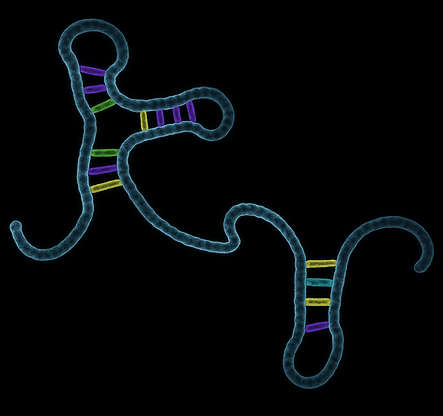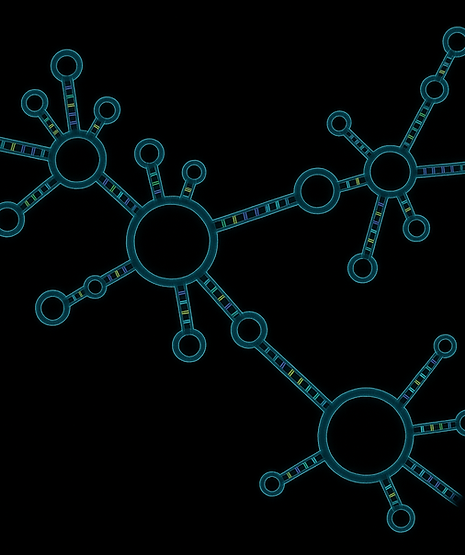passionate RNA researcher
It all started in velvety red chairs with a delicious tuna sandwich - who knew it would lead all the way to MIT researching RNA molecules and connecting it to the realms of quantum mechanics.

the RNA hook
As a 16 year old I started working as a biology lab technician apprentice at the pharmaceutical company F. Hoffman- La Roche in Switzerland. I learned how to conduct biological experiments in the lab, how to problem solve, think critically about experiments, and present results in a meaningful way. It was also here where I attended a lunch talk about RNA interference. A cellular phenomenon which discovery was awarded the Nobel Prize in 2007. I was fascinated about these short RNA molecules regulating complex cellular processes within cells and then dedicated my whole career to further understand RNA functions.
fascinating organisms with powerful RNA
During my undergraduate degree at the University of Bern in Switzerland I continued my focus on RNA research. I interned in labs where short RNAs were shown to regulate protein synthesis in bacteria cells and genome rearranging in unicellular organisms called Paramecium. I was struck by the phenomenon that RNA can instruct DNA, challenging the long-held belief that biology operates in strictly one-way pathways.
-
Determination of the presence of 5-methylcytosine in Paramecium tetraurelia
https://pubmed.ncbi.nlm.nih.gov/30379964/


floating RNAs
During my Master’s studies at the University of Amsterdam, I became intrigued by the RNAs released into bodily fluids. Using computational tools and machine learning algorithms, we identified RNA species detectable in human blood and evaluated their potential as early biomarkers for cancer diagnosis. This work laid the foundation for many future studies and challenged prevailing assumptions about RNA instability. Contrary to the mainstream narrative, we found that certain RNAs persist in circulation far longer than expected—reshaping our understanding and contributing to the ongoing rewriting of biology textbooks.
-
Platelet RNA as a circulating biomarker trove for cancer diagnostics https://pubmed.ncbi.nlm.nih.gov/28671345/
-
Swarm Intelligence-Enhanced Detection of Non-Small-Cell Lung Cancer Using Tumor-Educated Platelets
https://www.ncbi.nlm.nih.gov/pmc/articles/PMC6381325
-
Blood platelet RNA enables the detection of multiple sclerosis
https://journals.sagepub.com/doi/full/10.1177/2055217320946784
-
Tumor-Educated Platelet RNA for the Detection and (Pseudo)progression Monitoring of Glioblastoma
https://www.ncbi.nlm.nih.gov/pmc/articles/PMC7576690
-
Detection and localization of early- and late-stage cancers using platelet RNA
https://www.sciencedirect.com/science/article/pii/S1535610822003701
longer RNAs
During my graduate studies in Switzerland at the University of Bern, I continued investigating circulating short RNAs as blood-based biomarkers alongside Simon Häfliger. At the same time, I ventured into the enigmatic world of long RNA molecules with Rory Johnson and his lab. While the functions of many long noncoding RNAs remain poorly understood, our mission was to uncover which of these molecules play active roles in cancer biology. We identified several promising candidates with potential therapeutic relevance. Once again, our findings challenged the long-standing notion that long noncoding RNAs—often dismissed as mere products of "junk DNA"—are nonfunctional, offering new insights into the complexity and hidden logic of the genome.
-
CASPR, an analysis pipeline for single and paired guide RNA CRISPR screens, reveals optimal target selection for long noncoding RNAshttps://pubmed.ncbi.nlm.nih.gov/31681950/
-
Cancer LncRNA Census 2 (CLC2): an enhanced resource reveals clinical features of cancer lncRNAshttps://academic.oup.com/narcancer/article/3/2/zcab013/6225859?login=true
-
Multi-hallmark long noncoding RNA maps reveal non-small cell lung cancer vulnerabilities, https://www.cell.com/cell-genomics/fulltext/S2666-979X(22)00113-6
-
Tumour mutations in long noncoding RNAs that enhance cell fitnesshttps://www.nature.com/articles/s41467-023-39160-7
-
Circulating miRNAs as non-invasive biomarkers for diagnosis, prognosis, survival prediction under anti-PD-1 immunotherapy and response monitoring in Non-Small Cell Lung Cancer (NSCLC), https://www.nature.com/articles/s41416-024-02831-3


superstar RNA
And there it was—a long RNA molecule, remarkably abundant in lung cancer cells yet nearly undetectable in healthy tissue. Among nearly 700 RNA biomarkers I analyzed, this one stood out. Its levels were strikingly elevated in the blood of cancer patients, making it a promising candidate for early detection. Captivated by both its mystery and clinical potential, I crafted a research proposal to investigate it further. That same year, I was awarded a personal fellowship to pursue this work at the RNA Medicine Institute with Frank Slack and his team at Harvard Medical School in Boston.
-
Is Evolutionary Conservation a Useful Predictor for Cancer Long Noncoding RNAs? Insights from the Cancer LncRNA Census 3https://pubmed.ncbi.nlm.nih.gov/36548181/
-
Circulating Long Non-Coding RNAs (lncRNAs) as Diagnostic and Prognostic Biomarkers for Non-Small Cell Lung Cancer (NSCLC) Management (manuscript in preparation)
opposites attract
My time at Harvard expanded my view of RNA biology, revealing just how much remains to be uncovered. During my postdoctoral work in Rick Young’s lab, I investigated how the negative charge of RNA allows it to engage with positively charged regions of proteins. We found that these electrostatic interactions are not random or incidental—they play a critical role in organizing the 3D structure of DNA within the nucleus. The realization that such subtle, non-covalent forces can reshape the genome raises a profound question: What other cellular architectures or behaviors might they influence? And how soon will we need to rewrite our textbooks again?
-
Transcription factors interact with RNA to regulate genes
https://pubmed.ncbi.nlm.nih.gov/37402367/
-
Distinguishing features of transcription factor assemblies with regulatory and architectural functions (under review at Cell)


mysterious interactions
Throughout my career, I’ve been deeply fascinated by neuroscience, memory, cognition, and the mysteries of the human mind. Questions like, “How do we remember who we are when we wake up each morning?” have driven my curiosity. Emerging research suggests that complex protein networks within cells have the potential to process quantum information, opening new frontiers in understanding consciousness. Together with Dante Lauretta and Stuart Hameroff we are investigating these networks and their implications on behavior in unicellular organisms at the University of Arizona. These networks interact intimately with RNA, and I’m eager to explore this interplay further. My future work aims to bridge the gap between cognition and behavior through the lens of quantum biology, focusing on how interacting RNAs influence these fundamental processes.
The new era of research will be defined by the convergence of disciplines once thought unrelated. My own career path illustrates this shift: I began in biology, moved into biochemistry, then delved deeper into biophysics, and now explore the quantum mechanical nature of biological molecules. To unlock new frontiers, we must connect what once seemed disconnected and challenge conventional narratives to gain deeper insights and propel humanity forward.